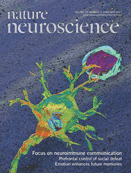 Only days after his paper was published online, a neuroscientist has posted a comment on PubMed alerting readers to several duplication errors.
Only days after his paper was published online, a neuroscientist has posted a comment on PubMed alerting readers to several duplication errors.
Despite the issues, which the researcher says were introduced into the final manuscript after peer review, he reassured readers that they do not influence the final conclusions in the paper.
On February 9, ten days after the article came online, corresponding author Garret Stuber at the University of North Carolina at Chapel Hill wrote a detailed comment on PubMed Commons, explaining that the “research community” had brought four figure-related errors to his attention. After investigating the concerns, Stuber discovered that the problems emerged after the peer-review process, “while revising the manuscript to comply with Nature Neuroscience’s final formatting guidelines.” In his note, he outlined the specific duplication issues that arose, which he says he plans to detail to the journal in a formal corrigendum letter.
Stuber alerted the scientific community about his PubMed comment via Twitter:
Please see my comments regarding our recently published NN paper. Please RT for the sake of science integrity.
Here’s what Stuber wrote on PubMed Commons regarding “Hormonal gain control of a medial preoptic area social reward circuit,” published online January 30 in Nature Neuroscience:
It has come to my attention that several errors are present within the Advanced Online Publication version of this manuscript (McHenry et al., in press, Nature Neuroscience). After careful examination of the figures and data, I have determined that these errors were introduced after the completion of the peer review process, while revising the manuscript to comply with Nature Neuroscience’s final formatting guidelines. Below are the details with respect to each item as well as steps I have taken to rectify these errors.
In his comment, Stuber describes the four figure duplication errors, and how he plans to fix them:
Figure 5b: Example calcium transient traces. Traces from Cell 1:Post, Cell 2:Pre, and Cell 3:Pre are duplicates of each other. We have re-extracted the raw data for all three cells from the motion corrected two photon imaging movies. We now show the correct traces for these three cells in a corrigendum letter we are submitting to the journal (see below).
Figure 8d: Laser off and on bars and data points for mPOA eYFP* and mPOA-VTA eYFP* are duplicates. This duplication occurred when reformatting the figure panel from a line graph to a dot plot in accordance with formatting guidelines for the journal.
Figure 8e: Laser off bars and data points for mPOA-VTA eYFP* and mPOA-VTA ChR2* are duplicates. This also occurred when reformatting the figure panel from a line graph to a dot plot in accordance with formatting guidelines for the journal.
Figure 1f: when zoomed in to this panel, small black rectangular artifacts are present within the image. We suspect these were introduced when the journal was typesetting the manuscript and figures because they are not apparent in either the raw confocal images or the illustrator files that were uploaded to the journal.
Stuber’s comment notes that he has already reached out to the journal editor to formally correct the issues, and clarifies that the errors “do not affect the main findings of the paper:”
As of 02/06/2017, I have contacted the journal editor who handled the submission of this manuscript to report this. I am now in the process of drafting a formal corrigendum that will be signed by all coauthors and submitted to the journal within the next week in order to provide accurate versions of the figure panels in question. Note that these changes do not affect the main findings of the paper and we continue to completely stand behind our work. In addition, all raw and analyzed data and previous versions of the manuscript will be made available by request.
I would like to thank those within the research community who have directly and indirectly brought these items to my attention. I apologize for any confusion these mistakes may have caused.
We contacted Stuber to learn more about how these errors came to his attention and how they may have been introduced during the paper’s final formatting phase. Stuber explained:
… I posted my comment on Pubmed commons in an effort for immediate notice and transparency to what occurred. I thought that this would be the best course of action in order to avoid any further confusion.
But he declined to comment further until he had a chance to discuss the matter with Nature Neuroscience, noting:
I do think coverage of how manuscripts are treated after peer review is complete through final publication is an important topic.
We commend Stuber for acting so promptly and transparently to alert readers to his concerns about his paper.
We reached out to the journal’s chief editor Kevin Da Silva for additional information and Alice Henchley, communications director at Springer Nature, responded on his behalf:
We are aware of Dr Stuber’s comment and are investigating the issues described in it. Until those investigations are complete, we cannot provide any further comment.
Nature Neuroscience details the editorial and submission process on its website, and specifies how to prepare and submit figures, in particular.
Like Retraction Watch? Consider making a tax-deductible contribution to support our growth. You can also follow us on Twitter, like us on Facebook, add us to your RSS reader, sign up on our homepage for an email every time there’s a new post, or subscribe to our daily digest. Click here to review our Comments Policy. For a sneak peek at what we’re working on, click here.
Transparent, yes, but not very classy to blame everyone but yourself. It’s the principal investigator’s responsibility to catch errors like this at the proof stage or earlier.